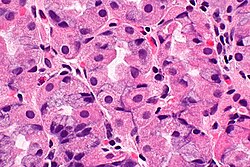Difference between revisions of "Proton pump inhibitor effect"
Jump to navigation
Jump to search

| Line 1: | Line 1: | ||
[[Image:Stomach with | [[Image:Stomach with prominent parietal cells -- very high mag.jpg|thumb|right|250px|Stomach with PPI effect. [[H&E stain]].]] | ||
'''Proton pump inhibitor effect''', abbreviated '''PPI effect''', is a change seen in the parietal cells of the [[stomach]] due to a drug in the proton pump inhibitor class. | '''Proton pump inhibitor effect''', abbreviated '''PPI effect''', is a change seen in the parietal cells of the [[stomach]] due to a drug in the proton pump inhibitor class. | ||
| Line 15: | Line 15: | ||
===Images=== | ===Images=== | ||
<gallery> | <gallery> | ||
Image: Stomach with | Image: Stomach with prominent parietal cells -- intermed mag.jpg | PPI effect - intermed. mag. | ||
Image: Stomach with | Image: Stomach with prominent parietal cells -- high mag.jpg | PPI effect - high mag. | ||
Image: Stomach with | Image: Stomach with prominent parietal cells -- very high mag.jpg | PPI effect - very high mag. | ||
</gallery> | </gallery> | ||
www: | www: | ||
Revision as of 00:11, 18 January 2014

Stomach with PPI effect. H&E stain.
Proton pump inhibitor effect, abbreviated PPI effect, is a change seen in the parietal cells of the stomach due to a drug in the proton pump inhibitor class.
Formally, it is stomach with proton pump inhibitor effect.
General
- Due to intake of a proton pump inhibitor (PPI).
- Used to treat gastroesophageal reflux disease.
Microscopic
Features:[1]
- Parietal cell enlargement - key feature.
- Parietal cells typically bulge into the lumen.
Images
www:
Sign out
- Usually not reported.


